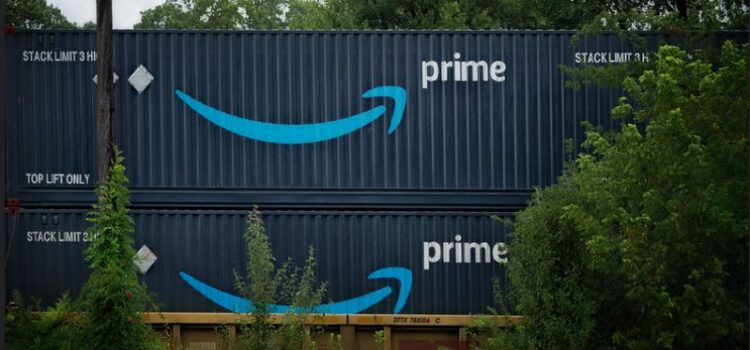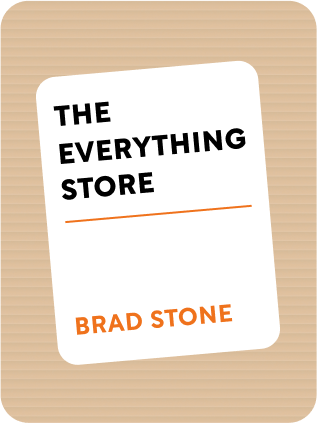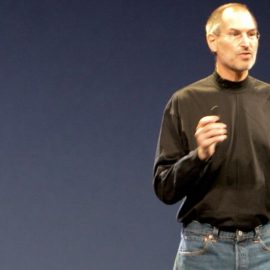

This article is an excerpt from the Shortform book guide to "The Everything Store" by Brad Stone. Shortform has the world's best summaries and analyses of books you should be reading.
Like this article? Sign up for a free trial here .
How did Amazon survive the 2007 recession? What did Amazon do to acquire Zappos and Diapers.com? Why did the Kindle cause so many problems?
Thanks to Amazon’s competitive advantage in the market, they managed to thrive during the 2007 recession. The additional money allowed them to control the online market, which gave many other companies no choice but to be acquired. However, Amazon’s success didn’t come without issue.
Keep reading to learn how Amazon slowly overtook the online market thanks to its competitive advantage.
Kindle Hits the Market
November 2007: Bezos introduces the Kindle at a press event, after 3 years of development in Lab126. This was a huge part of the Amazon competitive advantage.
- He releases a bombshell: digital versions of books will cost $9.99. He models this after Apple’s 99-cent iTunes song, believing that customers expect to pay less for a non-physical book.
- Publishers are blindsided, not having known about the price beforehand. They feel betrayed, after having partnered with Amazon to digitize their books for months. Physical retailers are scared, believing that customers will abandon physical books for e-books.
- Rightly, they fear Amazon will accrue even more negotiating leverage.
Amazon and the 2007 Recession
December 2007: The housing crisis causes a wide recession, destroying many retailers while Amazon is gaining momentum thanks to its competitive advantage.
- Circuit City goes bankrupt in 2008. At its peak, it had 700 stores and $12 billion in sales. Then Best Buy and Walmart ushered in self-service shopping and big-box stores. Circuit City is caught flat-footed, with its large, expensive salesforce and being distracted spinning out CarMax and DVD-rental system DIVX.
- Borders goes bankrupt in 2011. Over Amazon’s history, Borders was content to let Amazon run its online business and chose to focus on its physical stores. It perceived Amazon as “just another catalog – a version of Lands’ End.”
- In September 2009, Brad Stones writes “Can Amazon be the Wal-Mart of the Web?” Walmart tries to counter Amazon’s growth, lowering prices on ten new books to $10 each. Amazon matches the price within a few hours. This price pressure would have been terrifying to Amazon 10 years ago – but now Amazon can easily withstand such losses.
February 2008: Amazon sells its DVD-rental services in the UK and Germany to Lovefilm.
- Years earlier, Amazon had watched Netflix and attempted to replicate it in geographies Netflix hadn’t yet entered. But local companies were already there, and the cost to acquire customers was higher than Amazon expected.
- Amazon becomes the largest shareholder in Lovefilm, and watches from the sidelines as Netflix moves away from sending discs in the mail to streaming. (In 2011, more action will happen with Lovefilm.)
Amazon Acquires Zappos and Diapers.com
July 2009: Amazon announces the acquisition of Zappos for $900 million.
- After a long and painful war of attrition, Zappos ultimately loses.
- Zappos investor Michael Moritz had watched Amazon destroy eToys a decade earlier and knew what it takes to compete with Amazon. Zappos doesn’t have it. “The hiring was too slow, the engineering department was not good enough.” Zappos’s Las Vegas location made recruiting difficult.
- Zappos founders Hsieh and Lin also see that many Zappos employees had lost their wealth in the housing crisis, and the only thing of value they hold is Zappos stock. An exit would give them a payout, so the founders feel emotional pressure to sell at that time.
- In a welcome video to Zappos employees, Bezos records an 8-minute video introducing Amazon. Ironically, he says “we pay attention to what our competitors do, but it’s not where we get our energy or motivation.”
2009: Amazon approaches Quidsi, owner of Diapers.com, and announces they are ready to invest in the childcare market (diapers, formula, strollers) and that Quidsi should think about selling to Amazon. This is the Zappos story, playing out again.
- Quidsi was founded in 2005 by Marc Lore (later founder of Amazon competitor Jet.com) and Vinit Bharara. At the time, e-commerce retailers hadn’t yet approached diapers since the product feels bulky and low-margin.
- Quidsi makes the business work by reducing shipping costs, matching goods to the smallest possible box (with a range of 23 possible sizes) and building warehouses right outside major cities to use cheap ground shipping.
- They watch Amazon closely, calling Bezos “sensei” in private.
- After Quidsi’s rejection of Amazon’s offer, Amazon drops prices by up to 30% on diapers and other baby products. Quidsi changes their prices and watches Amazon move in lockstep, as a result of automated pricing bots.
- Quidsi’s growth slows, and investors are reluctant to invest further. Quidsi founders approach Walmart for acquisition, but the price isn’t high enough.
- In September 2010, they meet with Amazon. While the founders are locked up in that meeting, Amazon announces Amazon Mom in a press release. Diapers become available for under $30 with Amazon’s Subscribe & Save, while costing $45 on Diapers.com.
- Finally, Quidsi waves the white flag. Bezos wants to make sure they don’t lose the deal to Walmart and Amazon offers $540 million.
- Walmart counters at $600 million. Amazon suggests if they take the offer, Amazon will drive diaper prices to zero, destroying Quidsi’s economics and threatening to force the deal with Walmart fall through. They accept and announce the acquisition in November 2010.
- (Shortform note: apparently partially fueled by revenge for Amazon stealing his baby, Marc Lore later founds Jet.com, which is positioned as an Amazon competitor and ultimately sells to Walmart for $3 billion.)
Kindle’s Success
Fall 2009: Two years after the Kindle releases, Amazon commands 90% of the digital reading market and releases the Kindle 2. Publishers are terrified.
- Any publisher that doesn’t follow Amazon’s pricing terms gets cut off in product listings, its wares becoming available only through third-party sellers.
- Two major publishers try to delay e-book releases until months after the hardcover versions come out. Consumers react poorly, giving these titles poor reviews on Amazon. Even without Amazon exerting explicit pressure, its status as the central shopping destination is unbeatable leverage.
- Amazon is experimenting with allowing authors to self-publish their works in Kindle, giving them 70% royalty on sales. Amazon has control over so much of the chain that it can cut out publishers entirely.
- In response to all this, 5 major publishing houses representing a large fraction of books sold – Penguin, Hachette, Macmillan, HarperCollins, and Simon and Schuster – collude with Apple to address Amazon’s $9.99 problem.
- They agree to switch to an agency model, wherein publishers would become retailers and set their own prices (between $13-15) and Apple would act as the broker and get a 30% commission. Apple receives a guarantee that other retailers wouldn’t undercut it on e-book prices.
- In Jan 2010, Apple introduces the iPad and the new e-books.
- Amazon’s countermoves:
- In response, Amazon blocks Macmillan books for a weekend. This attracts the ire of press and customers – directed toward Amazon – and they reluctantly reverse.
- Ironically, the pricing collusion actually raises Kindle profits, since Amazon holds most of the e-book sales and is forced to charge more for e-books. Amazon takes advantage by lowering Kindle device prices to as low as $79.
- Amazon approaches smaller publishers, warning they have insufficient leverage to pull the same move, and threatening to stop carrying their books if they tried.
- Amazon sends a white paper to the FTC and DOJ suggesting there was an illegal conspiracy. The DOJ sues 3 years later, in 2012.
Amazon Fights Sales Tax
2010-11: Amazon’s size makes it a more attractive target for regulators for sales tax. They battle with states and other retailers to avoid state sales taxes.
- In April 2008, NY state passes legislation to expand the definition of tax nexus to include affiliate websites that took commissions for passing customers to an online retailer, thus making that retailer have a presence in the state. Amazon and Overstock sue, but they lose.
- IL, NC, RI, TX and other states follow the same strategy. In response, Amazon severs ties with affiliates in each state.
- To attack Amazon, Walmart, Target, Sears, and other retailers form a coalition to back a new organization called the Alliance for Main Street Fairness, pushing for the vitality of small retailers. This is ironic given the size of these retailers. But given that the retailers have physical presence in states and are taxed, they believe Amazon has an unfair advantage as an online retailer, and they want to try to hamper Amazon as they can.
- Amazon continues efforts to try to avoid establishing tax nexus, like rigid restrictions on what traveling employees could do in certain states, and setting up fulfillment centers as subsidiaries of Amazon with no revenue. It uses fulfillment centers as leverage to combat state legislation – threatening to close the Texas fulfillment center makes the governor veto the bill; TN delays the bill when Amazon offers to build 3 new fulfillment centers in the state.
- Amazon pushes for a federally controlled state tax (which as of 2018 has still not had meaningful traction).
- Ultimately in 2012, Amazon negotiates accommodations to allow staying tax-free for a few years, in exchange for putting fulfillment centers in each of Texas, South Carolina, Pennsylvania, Tennessee, and California.
Ever the chess player, Amazon uses this seemingly costly requirement to its strategic advantage – it builds fulfillment centers close to large cities, empowering next- or same-day delivery, AmazonFresh, and Amazon Lockers.

———End of Preview———
Like what you just read? Read the rest of the world's best book summary and analysis of Brad Stone's "The Everything Store" at Shortform .
Here's what you'll find in our full The Everything Store summary :
- How Amazon went from an online bookstore to the largest internet retailer in the world
- What Jeff Bezos did to compete with companies like eBay, Zappos, and Diapers.com
- What it was like to work for Jeff Bezos






